POSTURE! Why is it so important and how can having poor posture affect a variety of different things in the body? Posture is a term that is used quite often in the physical therapy setting, and one that I remind my patients about daily.
First, let’s review what “good posture,” should look like, and then talk about how deviations from this standard can affect the body.
Plumb Line/ Line of Gravity
It is important to consider that gravity is constantly weighing us down and keeping us grounded (I don’t think this is a surprise to anyone lol). With that being said, this constant force put’s pressure through our body, from the top of our head down to the floor. We can call this force a line of gravity. One of the ways we can assess if this line of gravity is running through your body efficiently is called the plumb line and we assess this in a side view.

From this side view position, the plumb line (red line) corresponds with the line of gravity and is placed in the midline of the body. It should pass through the ear lobe, mid shoulder, hip joint/femur, and then finish slightly in front of the outside ankle bone. This ideal alignment will ensure that no excess stress is being put on the joints and musculature of the body.
Negative Effects of Poor Posture:
Deviations from this ideal plumb line posture show up in many different ways and it is my job as a physiotherapist to assess this and find out where a person may be hindered. Generally, the most common deviation seen in the clinic is one of a forward head posture. One where the earlobes are positioned forward the plumb line. This specific change in body position is responsible for many things, most notably tight upper fiber traps/suboccipitals (muscles in the upper back/back of the neck), which manifest into tension headaches and neck/back pain.
How Physiotherapy Can Help:
When a departure in “good posture” is identified, our job as physiotherapists are to come up with tailored treatment plans to help correct this. Generally, my approach will include stretching the musculature in the body that is tight, and strengthening the muscles that have become weak. A home exercise program will also be assigned, as consistency is key in order to make meaningful change to one’s posture.
If you would like your posture assessed and are dealing with aches and pains, I would love to help!
Mike Salame, MScPT
Physiotherapist at Pivotal Physiotherapy

